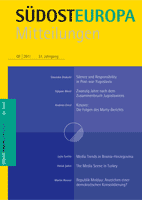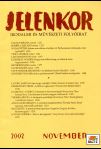
Multimedia: School’s Out
The wave of Syrian refugees into Bulgaria isn’t just a humanitarian crisis – it’s an educational crisis, too.
More...We kindly inform you that, as long as the subject affiliation of our 300.000+ articles is in progress, you might get unsufficient or no results on your third level or second level search. In this case, please broaden your search criteria.

The wave of Syrian refugees into Bulgaria isn’t just a humanitarian crisis – it’s an educational crisis, too.
More...
The first English translations of some of Kazakhstan’s best-known fiction writers and poets. The Stories of the Great Steppe: The Anthology of Modern Kazakh Literature
More...
The latter half of the 19th century in Romania was a time of unprecedented change and emancipation for Romanian women in regard to political engagement, legal status, access to higher education, and their entrance into the professions and public life. In addition, their visibility in the professional world of literature and arts enabled them to start forging a tradition of their own. The present article recovers and explores the work of a number of totally neglected Romanian writers and women writers. It assesses their achievement by examining their 19th century cultural impact on women’s changing social status and diversification and the reshaping of their lives.
More...
The TV information does not deliver a true part of reality, but evokes it through a system of connotations which suggest ideas. The elements of a TV report are mainly pictures and sounds, and not words and their illustrations. Pictures are going successively on the TV screen; meanwhile sounds are coming to us as words (dialogues and commentaries), noise and music. In this perspective, the production of the audiovisual informative message requires putting and working together in a specific way the two components: pictures and sounds. In the real language of television, words and illustrations will have to be left behind and you will have to think in terms of pictures and sounds. Each shot can go far beyond its literal meaning or denotation. Like any sign, a picture generates what semiologists call connotations. For example, the red and green of the peppers in an advertisement for “Panzani” pasta directly evokes the color of fresh vegetables, as well as the notion of things Italian. (Barthes 1964). When filming, you are not recording a slice of real life. From the very first frame, your choice of close-ups or wide shots, of depth of field, of how you organize the frames in your shot, all these elements create a system of connotations which suggests ideas. The role of the reporter, cameraman and editor will be to reduce any extraneous meanings to a minimum, so that they can be channeled into as simple and straightforward an interpretation as possible. The picture will have to be pinned down by the commentary to avoid its being left open to too many possible interpretations; its rhetoric will have to be mastered in order to put its evocative power to proper use. The use of rhetoric will enable you to find ideas which are at once richer but also sufficiently precise to refine the commentary as much as possible. “Rhetoric is, in the end, a catalogue of the different ways of being original. This creative process could therefore probably be made easier and richer if the creators of a work were consciously aware of a system which they usually use only intuitively.” (Durand 1970). Videojournalism – how to use the “ingredients”? A good television report consists of communicating information through pictures and sounds, and achieving a balance between them. An interview may be extremely interesting but no-one will listen to it if there is someone gesticulating behind the interviewee; the most exceptional pictures can be massacred by a verbose commentary, just as pictures which have too great an impact can prevent one from listening to the commentary which would give them their full meaning. A shot which draws too much attention to itself, an ambiguous phrase or a technical term will disturb and distract the audience. Except in the case of a live interview or broadcast, nothing must be improvised. If you neglect any one of the different elements of communication which make up the report, you will jeop
More...
A vast cultural circle closes with Robinson, one century after the adventure experienced by the Knight of the Sorrowful Countenance, in a realm of oscillating illusions. Man, as depicted by his literary effigy, reiterates the idea of divinity, the image of love, of the mythical couple, bringing into the foreground an image of exemplary singularity, which, while not excluding erotic fulfilment, stops considering it as essential or as the source of cosmic values. As the novel of the 19th century will show, from Balzac on, love becomes one of the modern man’s aspirations, alongside with glory, power, wealth, and career. This does not mean that the Platonist model is completely lost: it is always present, following different rules every time, a part of the many models which define modern existence.
More...
The American system has devolved managemnet functions away from academic ones, which has resulted in the emergence of a new professional group - academic managerswho are specialised in running higher education intitutions: colleges and universities or narrow-purpose institutions.
More...
In this second part of the article, I have further aimed at the narrative ways by which writers introduced the few references to the uniformity of clothing. Pudency, the grotesque aspects connected to an entire imagery of intimate clothing, as well as the categories of social uniforms prove not only a concern for the connotations of the communist clothes, but also their acceptance. Therefore, the sequences that deal with clothing issues are few, accidental and without critical perspective.
More...
An effort to change the way history is taught in Serbian schools runs aground.
More...
Plus, Kosovo Serb killed in Mitrovica, and mother of Uzbek accused of threatening Obama speaks out. Around the Bloc is TOL's daily digest of the important, the trivial, the tragic, the weird, and the sober from its coverage region.
More...
Bride kidnapping is such a provocative topic that I guess I figured that the practice had declined in Central Asia since I had heard less of it lately. How wrong I apparently was.
More...
More than 3 million out of 10 million Czechs live in paneláks
More...
Plus, Al Jazeera Balkans set to launch and Tajik-Russia relations hit a new low. Around the Bloc is TOL's daily digest of the important, the trivial, the tragic, the weird, and the sober from its coverage region.
More...
Katka shares her private pain over the detachment of the EU from its people.
More...
Eastern bloc countries look to their recent, troubled pasts for a possible tourism future.
More...
Öffentliche Jahreshauptversammlung und Mitgliederversammlung der Südosteuropa-Gesellschaft 2011 Regensburg, 4. und 5. März 2011 Bericht von Claudia Hopf, Grafing b. München Kunst in Südosteuropa zwischen südosteuropäischem Erbe und westlicher Beeinflussung Wissenschaftszentrum Ost- und Südosteuropa Regensburg Regensburg, 4. März 2011 Bericht von Hendrik Kraft, Berlin / Jena Rapprochement as a Paradigm Shift: Does the Wheel Come Full Circle in Ex-Yugoslavia? Veranstalter: Südost-Institut / Südosteuropa-Gesellschaft Regensburg, 11./12. Februar 2011 Bericht von Petra Bläss-Rafajlovski, Potsdam, und Esther Wahlen, Regensburg Media in Southeast Europe – Trends and Challenges Organizers: Southeast Europe Association (Südosteuropa-Gesellschaft) / Deutsche Welle (DW) Bonn, 22 / 23 November 2010 Report by Stephani Streloke, Bonn
More...
“Different points of view work and clash in the science of remembering the revolution, and they »elaborate« the feeling of a general incertitude of the past.” The interview is about the 2002 novel called Dear Liv by Iván Sándor, writer, essayist. The novel, spanning the second half of the twentieth century, in the center of which are the events of the 1956 Hungarian revolution, faces at the same time with the end-of-the-millenium dilemma of the loss of personality. The writer talks about the occurring poetical-methodological problems, and also about the problems of the genre of the novel.
More...
No one should expect the new coach of Bosnia and Herzegovina’s football team to stay on the sidelines.
More...
What is it about Belarus that brings out the best in photojournalists?
More...
As the countryside empties out and schools close, thousands of teachers lose perks and even their jobs.
More...
It took a joint effort by government, the UN, and IKEA to open a kindergarten in one Moldovan Romani settlement. Perhaps the next 50 will go more smoothly.
More...